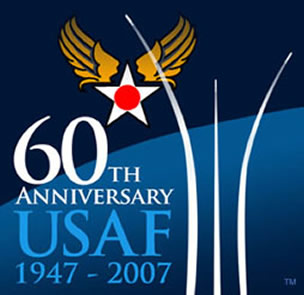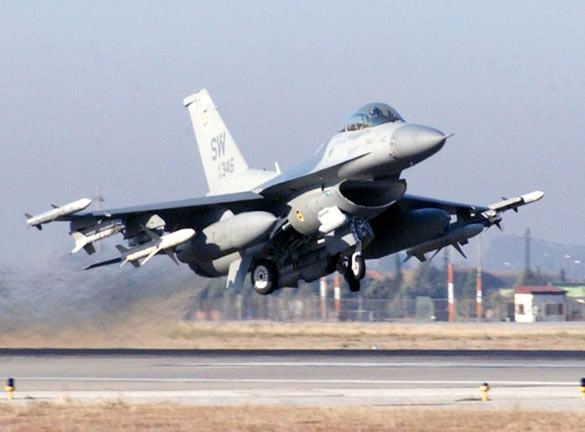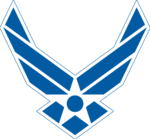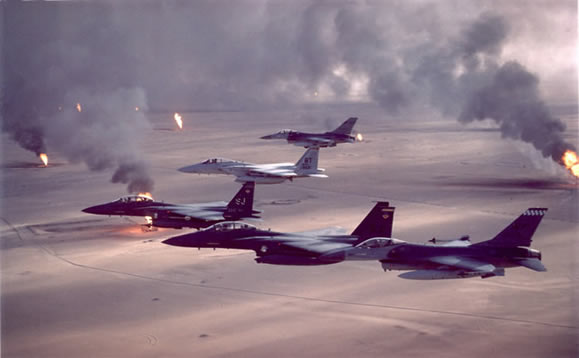THE UNITED STATES AIR FORCE HISTORY FACTS AND PICTURES
The United States Air Force Core Values -"Integrity First. Service Before Self. Excellence In All We Do."
 |
The United States Air Force (USAF) is the aerospace branch of the United States armed forces.The USAF was formed as a separate branch of the military on September 18, 1947 from the United States Army. The USAF is the largest modern air force in the world, with over 7,000 aircraft in service and about 358,600 men and women on active duty. Since World War I, the USAF and its predecessors have taken part in military conflicts throughout the world. The USAF is widely considered to be the most technologically advanced military air power. The stated mission of the USAF is "deliver sovereign options for the defense of the United States of America and its global interests -- to fly and fight in Air, Space, and Cyberspace". HISTORY - The USAF was first formed on September 18, 1947, following the passing of the National Security Act of 1947. The Act created the Department of Defense, which was composed of three branches, the Army, Navy and a newly created Air Force. Prior to 1947, military aviation was the responsibility of the Army, while the Navy maintained a fleet air arm on its fleet of aircraft carriers. The Army branch was known as the U.S. Army Air Corps and later the U.S. Army Air Forces. FORMATION - The U.S. military first began to experiment with military aviation in December 1906, when ‘‘Army Specification #486’’ was authorized, which looked into the creation of aircraft for military usage. In 1908, the Wright Brothers signed a contract with the Army to bolster the operations. The first air divisions were created following the establishment of an Aviation Section of the US Army Signal Corps. WORLD WAR I - In 1917, upon the United States' entry into World War I, the U.S. Army Air Service was formed as part of the American Expeditionary Force (AEF). Major General Mason Patrick commanded the AEF Air Forces; his deputy was Major General Billy Mitchell. The Air Service provided tactical support for the U.S. Army, especially during the Battle of Saint-Mihiel and the Meuse-Argonne offensives. Among the aces of the Air Service were Captain Eddie Rickenbacker and Frank Luke. In 1926 the Air Service was reorganized as a branch of the Army and became the U.S. Army Air Corps (USAAC). During this period, the USAAC began experimenting with new techniques, including air-to-air refueling and the development of the B-9 and the Martin B-10, the first all-metal monoplane bomber, and new fighters. In 1937, the B-17 Flying Fortress made its first appearance. In a spectacular feat of navigation, three B-17s intercepted the Italian passenger liner Rex at sea. WORLD WAR II - World War II led to further changes. In 1941, the Army Air Corps became the U.S. Army Air Force and the GHQ Air Force was redesignated the Air Force Combat Command. In the major military reorganization effective March 9, 1942, the newly designated United States Army Air Forces gained equal voice with the Army and Navy. In Europe, the USAAF began daylight bombing operations, over objections of the Royal Air Force planners on the Combined Chiefs of Staff. The US strategy involved flying bombers together, relying on the defensive firepower of a close formation. The tactic was only successful in part. American fliers took tremendous casualties during raids on the oil refineries of Ploiesti, Romania and the ball-bearing factories at Schweinfurt and Regensburg, Germany. When the P-51 Mustang, with its increased range, was introduced to combat, American combat losses dropped, and operations during Big Week in late winter of 1944 caused the Luftwaffe to lose experienced pilots. In the Pacific Theater of Operations, the USAAF used the B-29 Superfortress to launch attacks on the Japanese mainland from China. One of the major logistical efforts of the war, "flying the Hump" over the Himalayas, took place. To carry both a bomb load and fuel and to bomb at high altitude through the jet stream affected the B-29's range. As soon as airbases on Saipan were captured in 1944, General Curtis LeMay changed strategy from high-level precision bombings to low-level incendiary bombings, aimed at destroying the distributed network of Japanese industrial manufacturing. Many Japanese cities suffered extensive damage. Tokyo suffered a firestorm in which over 100,000 persons died. The B-29 was also used to drop one primitive nuclear weapon on each of the Japanese cities of Hiroshima and Nagasaki, in August 1945. POST WAR - The United States Department of the Air Force was created when President Harry S. Truman signed the National Security Act of 1947. It became effective September 18, 1947, when Chief Justice Fred M. Vinson administered the oath of office to the first secretary of the Air Force, Stuart Symington. Conflict over post-war military administration, especially as concerned the separate duties of the Air Force and the U.S. Navy, lead to an incident called the "Revolt of the Admirals" in the late 40s. The Korean War saw the Far Eastern Air Force losing its main airbase in Kimpo, South Korea, and forced to provide close air support to the defenders of the Pusan pocket from bases in Japan. However, General Douglas B. MacArthur's landing at Incheon in September 1950 enabled the FEAF to return to Kimpo and other bases, from which they supported MacArthur's drive to the Korean-Chinese border. When the Chinese People's Liberation Army attacked in December, 1950, the USAF provided tactical air support. The introduction of the Soviet-made MiG-15 caused problems for the B-29s used to bomb North Korea, but the USAF countered the MiGs with the F-86 Sabre. COLD WAR - Following the end of World War II, relations between the United States and the Soviet Union began to deteriorate, and the period in history known as the Cold War began. This period saw the United States enter an arms race with the Soviet Union, and competition to increase influence throughout the world. In response the United States expanded its military presence throughout the world. The USAF opened air bases throughout Europe, and later in Japan and South Korea. The United States also built air bases on the British overseas territories of British Indian Ocean Territory and Ascension Island in the South Atlantic. The first test for the USAF during the Cold War occurred in 1948 when Communist authorities in Eastern Germany cut off road and air transportation to West Berlin. The USAF, along with the Royal Air Force, supplied the city during the Berlin airlift, using C-121 Constellation and the C-54 Skymaster. The efforts of the USAF and RAF saved the city from starvation and forced the Soviets to back down in their blockade when they realized it wasn't working. VIETNAM WAR - The USAF were heavily deployed during the Vietnam War. The first bombing raids against North Vietnam occurred in 1965 following the Gulf of Tonkin Incident in 1964. Code named, Operation ROLLING THUNDER, the purpose was to destroy the will of the North Vietnamese to fight, to destroy industrial bases and air defences, and to stop the flow of men and supplies down the Ho Chi Minh Trail. The USAF was to drop more bombs during this campaign than all the bombs dropped during World War II. The bombing campaign lasted until 1968. The USAF also played a critical role in defeating the Eastertide Offensive of 1972. The rapid redeployment of fighters, bombers and attack aircraft help the South Vietnamese Army repel the invasion. Operation LINEBACKER demonstrated to both the North and South Vietnamese that even without significant U.S. Army ground forces, the United States could still influence the war. The air war for the United States ended with Operation LINEBACKER II also known as the Christmas Bombings. These helped to finalize the Paris peace negotiations BOSNIA AND KOSOVO - The USAF led NATO action in Bosnia in 1994 with air strikes against the Bosnian Serbs. This was the first time that USAF aircraft took part in military action as part of a NATO mission. The USAF led the strike forces as the only NATO air force with the capability to launch significant air strikes over a long period of time. Later the USAF led NATO air strikes against Serbia during the Kosovo War. The forces were later criticised for attacking civilian targets in Belgrade, including a strike on the civilian television station, and a later attack which destroyed the Chinese embassy. IRAQ AND AFGHANISTAN - The USAF provided the bulk of the Allied air power during the first Gulf War in 1991. The Stealth fighter's capabilities were shown on the first night of the air war when they were able to bomb central Baghdad and avoid the Iraqi's sophisticated anti-aircraft defenses. The USAF along with the USN and RAF later patrolled the skies of Northern and Southern Iraq after the war to protect minorities persecuted by the Iraqi regime under Saddam Hussein. In 2001, the USAF was deployed against the Taliban forces in Afghanistan. Operating from Diego Garcia, B-52 Stratofortress attacked Taliban positions, and deploying daisy cutter bombs for the first time since the Vietnam War. During this conflict the USAF opened up bases in Central Asia for the first time. The USAF was more recently deployed in the 2003 invasion of Iraq. Following the defeat of Saddam Hussein’s regime, the USAF took over Baghdad International Airport as a base. USAF aircraft are used to provide support to Coalition and Iraqi forces in major operations to eliminate insurgent centers of activity and supply in north and west Iraq. ORGANIZATION - The Department of the Air Force consists of the Office of the Secretary of the Air Force (SECAF), the Air Staff, and field units. SECAF - The HQ (Head Quarters) of the SECAF includes the Secretary, Under Secretary, Assistant Secretaries, General Counsel, The Inspector General, Air Reserve Forces Policy Committee, and other offices and positions established by law or the SECAF. The Office of the SECAF has responsibility for acquisition and auditing, comptroller issues (including financial management), inspector general matters, legislative affairs, and public affairs. In 2004 the Secretary of the Air Force was Dr. James G. Roche who stepped down as SECAF on January 20th, 2005. In 2005 the Secretary of the Air Force is Michael Wynne. AIR STAFF - The Air Staff primarily consists of military advisors to the CSAF and the SECAF. This includes the Chief of Staff, Vice Chief of Staff, and Assistant Vice Chief of Staff, the Chief Master Sergeant of the Air Force (CMSAF), four deputy chiefs of staff (DCS), the US Air Force Surgeon General, The Judge Advocate General, the Chief of the Air Force Reserve, and additional military and civilian personnel as the SECAF deems necessary. In 2005 the Chief of Staff of the Air Force was General (Gen) T. Michael Moseley. The Chief Master Sergeant of the Air Force is the senior enlisted person in the Air Force. In 2004 the position was held by Chief Master Sergeant (CMSgt) Gerald R. Murray. FIELD UNITS - The Department of the Air Force field units are MAJCOMs, field operating agencies (FOA), and direct reporting units (DRU). MAJOR COMMANDS (MAJCOMs) - The USAF is organized on a functional basis in the United States and a geographical basis overseas. A major command (MAJCOM) represents a major Air Force subdivision having a specific portion of the Air Force mission. Each MAJCOM is directly subordinate to HQ USAF. MAJCOMs are interrelated and complementary, providing offensive, defensive, and support elements. An operational command consists (in whole or in part) of strategic, tactical, space, or defense forces; or of flying forces that directly support such forces. A support command may provide supplies, weapon systems, support systems, operational support equipment, combat material, maintenance, surface transportation, education and training, or special services and other supported organizations. The USAF is organized into nine MAJCOMS (7 Functional and 2 Geographic) and the Air National Guard reporting to Headquarters, United States Air Force (HQ USAF). NUMBERED AIR FORCES - (NAF) - The NAF is a level of command directly under a MAJCOM (Major Command). NAFs are tactical echelons that provide operational leadership and supervision. They are not management headquarters and do not have complete functional staffs. Many NAFs are responsible for MAJCOM operations in a specific geographic region or theater of operations. A NAF is assigned subordinate units, such as wings, groups, and squadrons. WINGS - The wing is a level of command below the NAF. A wing has approximately 1,000 to 5,000 personnel and a distinct mission with significant scope. It is responsible for maintaining the installation and may have several squadrons in more than one dependent group. A wing may be an operational wing, an air base wing, or a specialized mission wing. OPERATIONAL WING - An operational wing is one that has an operations group and related operational mission activity assigned to it. When an operational wing performs the primary mission of the base, it usually maintains and operates the base. In addition, an operational wing is capable of self-support in functional areas like maintenance, supply, and munitions, as needed. When an operational wing is a tenant organization, the host command provides it with varying degrees of base and logistics support. AIR BASE WING - Some bases which do not have operational wings or are too large or diverse for one wing will have an Air Base Wing (ABW). The ABW performs a support function rather than an operational mission. It maintains and operates a base. An air base wing often provides functional support to a MAJCOM headquarters. Wings are composed of several groups with different functional responsibilities. Groups are composed of several squadrons, each of which has one major responsibility or flying one type of aircraft. Squadrons are composed of two or more flights. INDEPENDENT GROUPS - The last level of independent operation is the group level. When an organization is not part of the primary mission of the base it will be made an independent group. They may report to a wing (the 23d Fighter Group (Pope AFB) belongs to the 4th Fighter Wing (Seymour Johnson AFB)) or they may be completely independent (the 317th Airlift Group at Dyess AFB). They may also be organized as an expeditionary unit, independent but too small to warrant a wing designation. The organization of the independent group is usually similar to the operations group, but with a few squadrons or flight from the support side added to make the organization more self-sufficient, but not large enough to become a wing. OPERATIONAL ORGANIZATION - The above organizational structure is responsible for the peacetime Organization, Equipping, and Training of aerospace units for operational missions. When required to support operational missions, the National Command Authority directs a Change in Operational Control (CHOP) of these units from their peacetime alignment to a Combatant Commander (COCOM). AEROSPACE EXPEDITIONARY TASK FORCE (ASETF) - CHOPPED units are referred to as "forces". The top-level structure of these forces is the Aerospace Expeditionary Task Force (ASETF). The ASETF is the Air Force presentation of forces to a COCOM for the employment of Air Power. Each COCOM is supported by a standing Warfighting Headquarters (WFHQ) to provide planning and execution of aerospace forces in support of COCOM requirements. Each WFHQ consists of a Commander, Air Force Forces (CCMAFFOR), and AFFOR staff, and an Air Operations Center (AOC). As needed to support multiple Joint Force Commanders (JFC) in the COCOM's Area of Responsibility (AOR), the WFHQ may deploy Air Component Coordinate Elements (ACCE) to liaise with the JFC. COMMANDER, AIR FORCE FORCES (COMAFFOR) - The COMAFFOR is the senior Air Force officer responsible for the employment of Air Power is support of JFC objectives. The COMAFFOR has a special staff and an A-Staff to ensure assigned or attached forces are properly organized, equipped, and trained to support the operational mission. AIR OPERATIONS CENTER (AOC) - The AOC is the COMAFFOR's Command and Control (C²) center. This center is responsible for planning and executing air power missions in support of JFC objectives. AIR EXPEDITIONARY WINGS/GROUPS/SQUADRONS - The ASETF generates air power to support COCOM objectives from Air Expeditionary Wings (AEW) or Air Expeditionary Groups (AEG). These units are responsible for receiving combat forces from Air Force MAJCOMs, preparing these forces for operational missions, launching and recovering these forces, and eventually returning forces to the MAJCOMs. Theater Air Control Systems control employment of forces during these missions. USAF AIRCRAFT - The United States Air Force has roughly over 7,500 Aircraft commissioned as of 2004.(1) It currently employs a designation and naming system to identify all aircraft type with distinct names. Until 1962, both the Army and Air Force maintained one system, while the U.S. Navy maintained a separate system. In 1962,these were unified into a single system heavily reflecting the Army/Air Force method. For more complete information on the workings of this system, refer to United States Department of Defense Aerospace Vehicle Designations. CURRENT AIRCRAFT USED BY THE USAF:
A-10A/C Thunderbolt II AC-130H/U Spectre/Spooky II An-32 (leased) AT-38B Talon B-1B Lancer B-2A Spirit B-52H Stratofortress C-5A/B/C Galaxy C-9A Nightingale C-12C/D/F Huron C-17A Globemaster III C-20A/B/C Gulfstream III C-20H Gulfstream IV C-22B C-25A C-26B C-29A (HS.125-800) C-32A C-37A Gulfsteam V C-38A Astra C-40B C-41A C-130E/H/J Hercules C-135C/E/K Stratolifter C-141B/C Starlifter CC-130J Cessna 150M CN-235-100 CV-22B Osprey E-3B/C Sentry E-4B E-8C JSTARS E-9A EC-137D Stratoliner F-4F Phantom II F-15A/B/C/D Eagle F-15E Strike Eagle F-16A/B/C/D Fighting Falcon F-22A Raptor F-117A Nighthawk HC-130H/N/P HH-60G Pave Hawk KC-135E/R/T Stratotanker KC-10A Extender LC-130H MC-130E/H Combat Talon II MC-130N/P Combat Shadow MH-53J/M Pave Low III/IV MQ-1B Predator NB-52B 'Mother Ship' NC/C-21A Learjet NC-130A/E NC-135B/E/W NCH-53A Sea Stallion NT-39A/B Sabreliner OA-10A Thunderbolt II OC-135B QF-4E/G Phantom II RQ-1A/B Predator RQ-4A Global Hawk RC-135S/U/V/W T-1A Jayhawk T-6A Texan II T-37B Tweet T-38A/B Talon T-41D TC-18E TC-135S/W TE-8A TG-3A TG-4A TG-7A TG-9A TG-10B/C/D TG-11A TU-2S U-2R/S Dragon Lady UC-26C UV-18A/B Twin Otter UV-20A Chiricua UH-1N Iroquois VC-9C Nightingale VC-137C WC-130H/J WC-135C/W |
© AviationExplorer.com - The Website For Aviation Enthusiasts |







